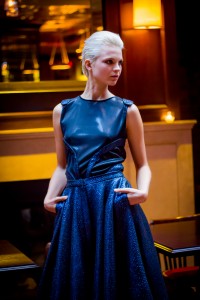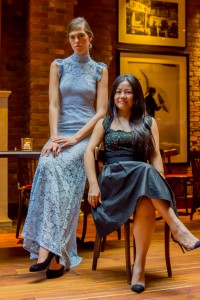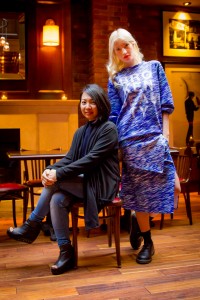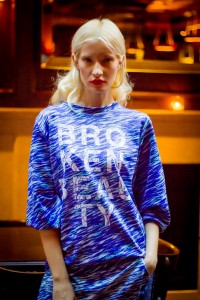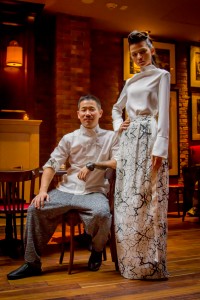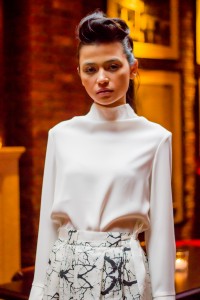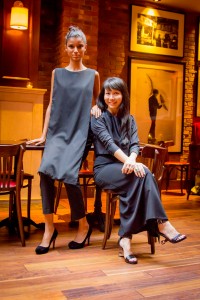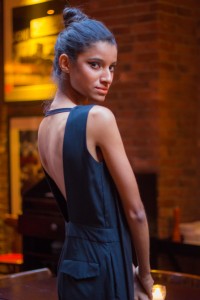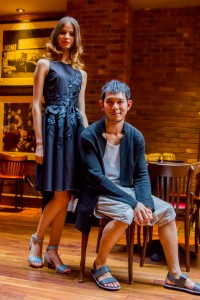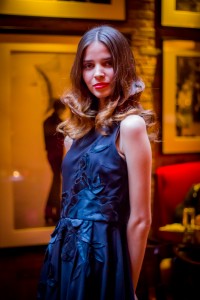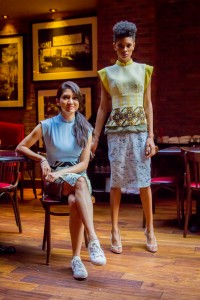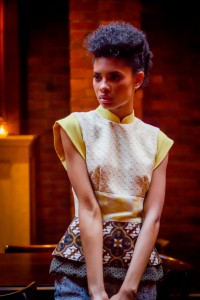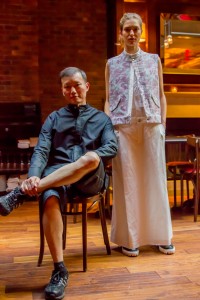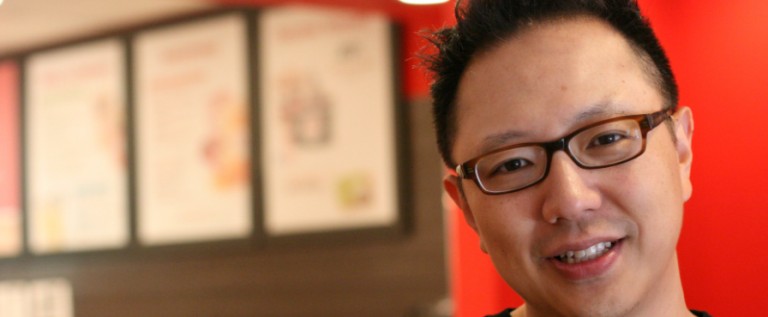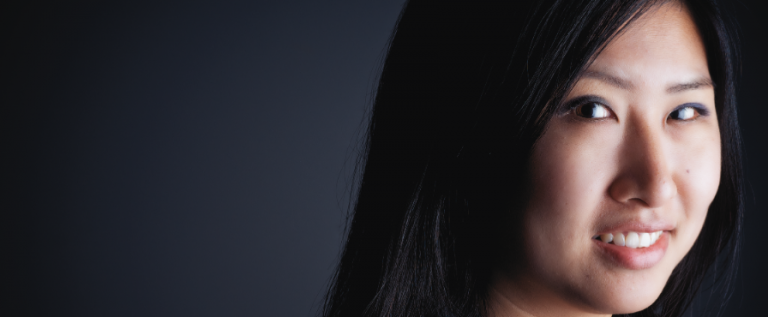Singapore is Fashion Forward By Catherine Law and Photos By Jackie Ho

The globalization of high fashion brought eight talented Singaporean designers to New York Fashion Week this past September for a Singapore Designers showcase at the Jade Hotel in Greenwich Village. Their Spring/Summer 2014-2015 lines were gorgeous and delightful, taking inspiration from classic feminine silhouettes, Japanese pottery and more.
Meet them all below, and learn about their careers and creations.
“Interrupted” by Pauline Lim
Pauline Lim’s SS14-15 collection for her brand Pauline.Ning integrates structure with soft layers, where it has a mixture of opposites. This is her third season presenting in New York, and she finds that New Yorkers are more receptive of fashion than Singaporeans.
Lim pursued a career in fashion due to her love of arts and crafts when she was younger. She has been designing for five years and feels blessed to have supportive parents. Lim believes that in order to be successful as a designer, you need to know techniques such as drafting and draping, which allows the designer to execute and conceptualize his or her vision.
What is also important that was not taught in school is the “importance of business of fashion,” she noted. Business and design are two opposite sides of starting a label, and a balance is necessary. “Being creative and doing business is totally different,” Lim said, adding that she has someone handling the business side of her label so she can “focus (my) energy on what I’m good at.”
So what is next for Lim? For the next year, she will focus on the U.S. market and hopes to have a show in Copenhagen.
“Fly Home” by Danelle Woo
Danelle Woo’s collection for her brand Aijek featured romantic and feminine fabrics and cuts. This was her first time in New York as last year she was in Las Vegas.
Woo began working in retail at the age of 14; she enjoyed it and felt comfortable but did not pursue fashion as a career at first. She was doing public relations before she created her label. “Public relations is harder and not true to you,” she explained.
Her philosophy from day one has been to have a “determination and a never say no attitude.” Woo stays up-to-date with fashion by visiting online forums to look at what people are talking about and what they want to buy. She described her personal style as classic and comfortable.
Woo does not see herself as a designer but as “an everyday woman, who knows the troubles of a woman” in regards to how to mix and match and how to create illusions to flatter the body. When designing, she thinks about the beauty and the texture and how she can imagine the woman in the dress — how the inner construction of it will fit and look good.
“We are not all a standard size,” Woo acknowledged. “Alterations always help – the magic of alterations!” She recognized that not all dresses are ready or appropriate for all women body types; finding the right dress is more about feeling confident in than numbers or sizes.
“Broken Beauty” by Sabrina Goh
The designer behind ELOHIM takes her inspiration from kintsugi, the Japanese aesthetic art of repairing broken pottery with silver and gold lacquer. For this season’s collection, Sabrina Goh found her creativity fueled by the kintsugi concept of displaying “brokenness” instead of hiding the flaws.
The Singapore Designer Showcase was the first trip to New York for Goh, who has spent six years in the industry. It was always her dream to do fashion. She initially thought “fashion was fun, can wear clothes and different clothes everyday, shopping”; only after actually working in fashion did she realize that “it’s a lot of hard work.”
When she studied fashion, Goh found that there was a big gap where the commercial aspect for the designers was not taught. “School will teach you to develop your designs,” she said, but not how to run your label.
Her advice for young designers is to be “persistent and to persevere” and “learn how to be yourself and how to stand out from the crowd.” Upon reflecting on her brand’s milestones, Goh reminds herself that it is “important to never stop learning and never stop growing.”
“White” by Del Chen
Del Chen’s SS14-15 collection for his eponymous brand is luxurious and easy to wear, featuring hand-drawn prints made for the modern woman’s figure. This collection was inspired by Lin Daiyu’s beauty from “Dream of the Red Chamber,” a classic Chinese novel about two aristocratic families.
Chen’s previous occupation was in graphic design before he became a designer and studied in Shanghai at the Raffles Institute of Design. He found it natural to switch from being a graphic designer to a fashion designer, as he loved to do patterns. Del has a “self-style”, where he will design things that a girl might wear.
His ideas come from life, as simple as getting up in the morning and drinking his coffee. Chen said he used to have time to play around but now he works six days a week; on the weekends, he meets with his designer friends to talk about ideas.
To Chen, fashion is “about the life, everyday.” He is already working on his next collection but hopes to come back to live in New York in a few years and perhaps attend a design school to learn even more.
“Till The Next Sunrise…” by Elyn Wong
Elyn Wong’s collection for her brand Stolen can be described as femininely elegant with her signature backless designs — she believes the back is one of the most elegant parts of the woman’s body. For this collection, she concentrated on the short-lived beauty of sunrise: Her palate mimics the transition of the sky from bright orange to blinding white to midnight black.
This was Wong’s second showing in New York and she was excited to be back as this year she was more business- and results-driven. Wong’s background was in visual communications, not fashion, and she worked in advertising for 15 years before spending the last 10 years doing fashion. Wong started designing dresses as a pet project, and described her label as a “creative outlet that took off and started to sell more and more.”
Wong found that to succeed in fashion, she needed to be “ready to be curious” and “very focused on what you want, your direction, your philosophy of your brand — as it can easily be wavered off.” She stands by philosophy to “be true to your passion and be true to your direction.”
For inspiration, Wong looks through magazines, not just fashion ones but also art and architectural magazines. She does not spend a lot of time designing anymore ever since starting Stolen because “there is so much to do” as she handles sides, designing, business, marketing and production.
Wong’s taste is very simple; she likes classic pieces and does not follow trends — as she grew older, she came to prefer the classics because they last longer. Her dream store is to have “a half gallery and half store, not in the city but by lake and by [a] mountain range.”
Whole9Yards by Daniel Ngoo
Daniel Ngoo’s SS14-15 collection drew on a vintage theme, featuring a throwback to femininity from the 1950s (think Audrey Hepburn and Grace Kelly). His pieces accentuate the female silhouette with a touch of floral design.
Fashion has been part of Ngoo’s life since he was young — his mother was very fashionable. A traditional Chinese parent, Wong’s father was against him studying fashion because it “doesn’t make a penny” and a “fashion designer is just sewing,” but Ngoo persevered in working toward his passion. If he had not pursued fashion, Ngoo would have been an archeologist. He loves rocks, dinosaurs and pre-historical things.
Ngoo’s concepts for each Whole9Yards collection take about a month, and then the development period takes about three months. The creative process flows naturally. “Ideas just come,” he said; then he simply applies the idea to a dress.
His advice to upcoming designers is to “be passionate, be practical and be humble, open up self and listen to the customer’s point of view.” He warns against the arrogance he has seen in other young designers, who refuse to take feedback from consumers, only other “artists.”
Ong Shunmugam by Priscilla Shunmugam
Priscilla Shunmugam summarized her SS14-15 collection as: “Madness is here, at the heart of things and of men, an ironic sign that misplaces the guideposts between the real and the chimerical, barely retaining the memory of the great of the tragic threats – a life more disturbed than disturbing, an absurd agitation in society, the mobility of reason.” Her collection is a reimagining of traditional Asian dress
Shunmugam took about 11 months to develop this collection, drawing inspiration from books – she takes a more intellectual approach to her designs. She studied law before switching to fashion, studying dress-making in London for a year, and only started designing about three and a half years ago. Shunmugam’s parents took the news hard as it is a “competitive industry and it’s not for everyone,” she said.
She finds that “innate aesthetics” and a “good eye” are important skills for designers. Her process consists of “a blank paper while having my hair colored,” and the opportunity to “blank out everything” else.
Shunmugam hopes to design a menswear line in a couple of years; for now, she is is in search of more traditional Asian textiles and looking forward to her upcoming trips to Nepal and Laos.
STYL.MYL by Kolin Chong
Kolin Chong’s SS14-15 collection for STYL.MYL features stylish and unique pieces that can be worn by men and women; the designs are modern, clean, elegant and contemporary, and were inspired by everyday materials.
Chong is one of the few designers who did not start out in fashion: His background was in accounting, which he did for 10 years before he starting his label in 2013.
For this collection, he designed a universal jumpsuit — for men and women. Chong’s focus when designing is on fit. “New inspiration can be defined from old fashion,” he said, noting that he takes inspiration from traveling as well.
Coming from a business background, Chong finds that designers need certain basic business skills, like sales, public relations and “commercial sense.” To aspiring designers, his advice is to “stay focused and follow your dreams.”


